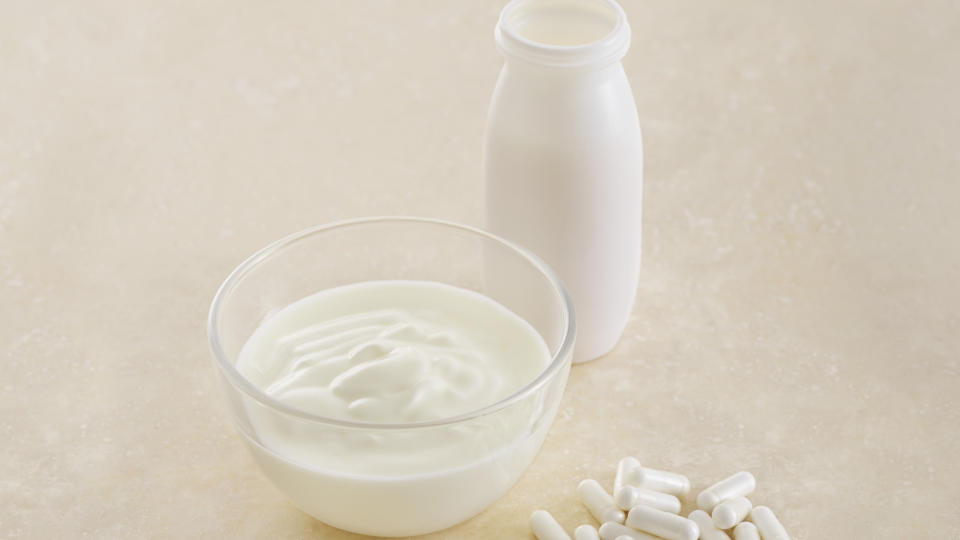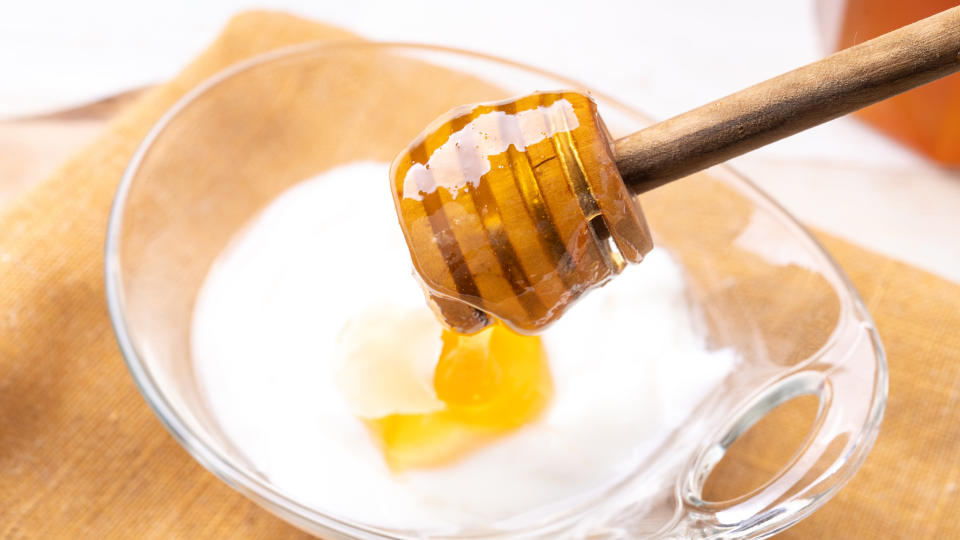The Key To Healthy, Younger-Looking Skin? Dermatologists Say It’s Probiotics
You've likely heard of probiotics, the beneficial bacteria found in foods like yogurt, as being good for gut health. But it turns out they can do more that just keep your digestive system running smoothly. When applied topically to the skin, probiotics can help calm common complexion bothers, too. Find out how to tap into the healing powers of probiotics for skin health (including an easy DIY recipe!), then choose treatment best suited to your needs for a more radiant, youthful complexion.
What are probiotics?
“Probiotics are live cultures of bacteria used either topically or systemically for medicinal or cosmetic purposes,” explains Kristina Collins, MD, FAAD, double board-certified dermatologist and founder of foy by Dr. Collins. Your entire body, including your skin, is naturally filled with trillions of both good and bad microorganisms. Probiotics are beneficial microorganisms that help regulate key systems in your body, such as skin health, gut health and the digestive system, says Rachel Lee Lozina, New York State Licensed Esthetician and Founder of Blue Water Spa in Oyster Bay, New York.
They are a vital part of keeping your microbiome, the collection of microbes living on and inside your body, balanced, says Valerie Aparovich, biochemist and certified cosmetologist-aesthetician at OnSkin. Why is that important? “Imbalanced microbiome composition can result in multiple health concerns, from compromised digestion to weakened immune responses," Aparovich says. "This increases the risk of severe infections and inflammatory conditions, including inflammation-related skin disorders like acne, eczema and rosacea.” (Tip: If you have a skin condition like eczema, click through to learn how tea tree oil can help.)
While many people supplement with a probiotic capsule daily to get the health benefits, the "good guy" bacteria are also found naturally in certain foods. The top natural sources: Fermented foods such as yogurt, kefir (a fermented milk drink), sauerkraut (fermented cabbage), kimchi (fermented vegetables) and miso (a seasoning made from fermented soybeans).

Why probiotics are beneficial to skin health
When applied topically, probiotics can "feed" the good-for-you bacteria living on your skin to calm irritation and diminish signs of aging. “Topical probiotics focus on normalizing the skin’s microbiome and strengthening the skin’s protective barrier," Aparovich says. "This helps it resist environmental damage, keep pathogenic bacteria at bay and regulate inflammation."
What's more, probiotics have been shown to help treat a variety of skin conditions including acne, eczema, psoriasis, seborrheic dermatitis and rosacea, Dr. Collins adds. And she says it also may have hydrating, anti-inflammatory and anti-aging benefits for the skin. By boosting your skin defenses with probiotics, you also reduce free radical damage and oxidative stress caused by UV radiation and air pollution, Aparovich says. As a result, you'll enjoy a healthier skin texture and complexion.
The best probiotics for skin health
While there are many different strains of probiotics that can be beneficial for skin health, there are three that stand out: lactobacillus, bifida ferment lysate and streptococcus thermophilus ferment. Simply choosing the one tailored to your needs can ease redness and irritation, fade the look of fine lines and soften rough patches of skin.
1. Soothe irritated skin with a lactobacillus mask
If you're prone to irritated or inflamed skin, Lactobacillus can help. It works by strengthening skin’s barrier to ease redness and inflammation, says Aparovich. While many store-bought cosmetic products contain lactobacillus (listed as Lactobacillus Ferment Lysate, Lactobacillus Ferment and Lactococcus Ferment Lysate among the ingredients), you can make your own natural lactobacillus-infused mask using a little Greek yogurt and honey!
“Greek yogurt is an excellent source of probiotics, making it a ready-to-use face mask,” notes Aparovich. The kitchen staple is rich in lactobacillus probiotics. The beneficial bacteria work together with honey’s oligosaccharides — a “bio-selective” sugar molecule that feeds only the healthy bacteria — to increase the number of “good bugs” on the skin. When combined, the duo deeply hydrates, repairs and removes impurities and harmful bacteria from the skin’s surface.

To make your own skin-healing mask, simply combine 2 Tbs. of Greek yogurt and 2 tsp. of honey. Smooth the mixture onto clean skin and let sit 15 minutes before rinsing. Repeat twice weekly for best results. No time to make your own mask? No problem! Try a premade lactobacillus-infused face mask like LACTO-DERM Beneficial Heartleaf Facial Mask Sheet with Lactobacillus (Buy from Amazon, $16).
Tip: Leftover ingredients from your homemade mask? Click through to learn how yogurt and honey calm heartburn, too!
2. Fade fine lines with a bifida ferment lysate toner
Notice more pesky fine lines and wrinkles pop up lately? It's probiotics to the rescue! “Inflammation caused by an excess of harmful bacteria in the skin can damage collagen and elastin, which leads to sagging, fine lines and wrinkles,” explains Sejal Shah, MD, a dermatologist in New York City. But applying a toner that contains bifidobacterium-derived bifida ferment lysate can diminish signs of aging. The probiotic balances skin-irritating “bad bugs” and stimulates skin at a cellular level. This increases production of firming collagen and elastin.
In addition, the probiotic strain boosts production of skin’s anti-aging antioxidants (which help fight against inflammation) and hyaluronic acid (which locks moisture into skin cells) for a soft, youthful glow. One to try: ma:nyo Bifida Biome Ampoule Face Toner (Buy from Amazon, $17.50).
Related: ‘I’m a Dermatologist And Here’s Why I Tell My Patients to Use Hyaluronic Acid Daily!’
3. Soften dry skin with a streptococcus thermophilus ferment cream
As we age, developing patches of dry skin becomes more common. And the problem tends to worsen in winter when cold, dry air saps much-needed moisture from your complexion. What can help: Increasing skin's production of fats or lipids known as ceramides. The probiotic strain streptococcus thermophilus ferment is especially suited to this job, says Aparovich.
“Ceramides are fatty molecules capable of trapping and retaining moisture in the skin," Aparovich explains. "They improve skin's natural hydrolipid barrier, soothing inflammatory response and banishing redness and irritation. Streptococcus thermophilus ferment helps increase ceramide content in the skin, restoring its hydrolipid barrier and easing irritation.”
To get the benefits, apply a lotion or cream containing streptococcus thermophilus ferment to dry patches of skin twice daily. One to try: Saturday Skin Pretty Pop Probiotic Power Whipped Cream (Buy from Amazon, $45). (Tip: If you have stubborn parched patches that need an extra hydrating boost, click through to discover the best dry oils for skin.)
For more on the total-body benefits of probiotics:
Never Buy Probiotics Again — Use This Simple Process to Make Yogurt At Home
Walk Off the Weight Using Probiotics — Here’s How
The Best Gut-Healing Probiotics for Women Over 50
This content is not a substitute for professional medical advice or diagnosis. Always consult your physician before pursuing any treatment plan.
Woman's World aims to feature only the best products and services. We update when possible, but deals expire and prices can change. If you buy something via one of our links, we may earn a commission. Questions? Reach us at [email protected]
